PageContent
Alcune Realizzazioni del Centro di Elettronica Bologna
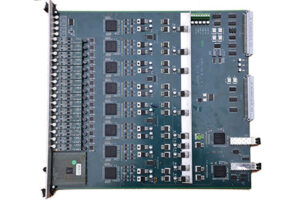
LUCROD: Scheda di readout per esperimenti LHC al Cern
- Standard VME 9U con 10 FPGA Intel Cyclone IV
- 16 canali analogici con conversione digitale 12 bit fino a 500MS con offset e guadagno programmabili
- 16 canali analogici di uscita con offset e guadagno programmabili
- 4 Ingressi/uscite NIM/TTL
- 2 transceiver ottici da 2Gb
- Alloggiamento per una scheda TTCrq del Cern
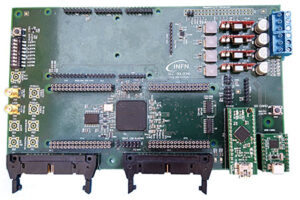
Polar-FPGA: Scheda di acquisizione dati, progettata per telescopi a raggi cosmici a basso consumo
- 1 FPGA Intel Cyclone V
- Fino a 32 ingressi LVDS
- 2 seriali USB
- Interfacciabile con Raspberry Pi, Arduino e moduli GPS
- Alloggiamento per una scheda figlia con chip HPTDC del Cern
![Digitizer GSPSv2 con Analog Input Board [FAMU] Digitizer GSPSv2 con Analog Input Board [FAMU]](/elettronica/wp-content/uploads/sites/14/2021/03/digitizer-gspsv2-300x200.jpg)
Digitizer GSPSv2 con Analog Input Board [FAMU]
- scheda di conversione analogico-digitale a 8 canali
- 4 ADC a due canali AD9684: 14 bit, 500 MS/s
- architettura configurabile tramite mezzanine analogiche che consentono l’interlacciamento
- sistema di controllo con Enclustra Mercury+ XU1 con Xilinx’s Zynq UltraScale+™ MPSoC
- interfacce: 2 Gigabit Ethernet, USB 3.0, Display Port, SATA
![Scheda HW switch Box [ATLAS] Scheda HW switch Box [ATLAS]](/elettronica/wp-content/uploads/sites/14/2021/03/hw-switch-300x200.jpg)
Scheda HW switch Box [ATLAS]
- Box HV multiplexer con selezione programmabile dei singoli canali di output, per la misura delle curve IV necessarie ai test di qualifica di moduli ibridi del tracciatore ITk.
160 x 160 x 51.5 mm
![Scheda Orbital Detector [FAMU] Scheda Orbital Detector [FAMU]](/elettronica/wp-content/uploads/sites/14/2021/03/orbital-detector-300x200.jpg)
Scheda Orbital Detector [FAMU]
- Elettronica di front-end per 6 rivelatori basati su LaBr3 accoppiati con fotomoltiplicatori (PMT) Hamamatsu ad alta efficienza quantica
- Disposizione dei componenti RADIALE sull’intera scheda
- PCB semi-circolare progettato per HV fino a 1500V
- Baseline Restorer per ogni singolo PMT
- Gestione di tutti i parametri mediante microcontrollers Teensy 3.5 pilotabili da remoto
366 x 183 mm
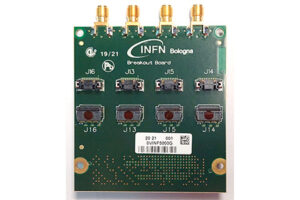
Breakout board ad alto rate con connettori Samtec Firefly (Arcadia)
- scheda di conversione da connettore FMC a 4 connettori Firefly ECUE
- 48 linee differenziali con rate di 640 Mbps
- 8 strati
69 x 60 mm
![Scheda rigido-flessibile SiPM Flex per matrici di SiPM [Grant SipMat] Scheda rigido-flessibile SiPM Flex per matrici di SiPM [Grant SipMat]](/elettronica/wp-content/uploads/sites/14/2021/03/sipm-flex-300x200.jpg)
Scheda rigido-flessibile SiPM Flex per matrici di SiPM [Grant SipMat]
- PCB FLEX 4 Layers in Kapton
- Tracce a impedenza controllata
- Montaggio, del chip BGA (contenente 64 SiPM) e dei connettori, su Kapton
- Funzionamento in ambiente criogenico
458 x 33 x 0.368mm
![SIPM_AMPLI [SHIP] SIPM_AMPLI [SHIP]](/elettronica/wp-content/uploads/sites/14/2020/05/SIPM_AMPLI-300x200.jpg) SIPM_AMPLI [SHIP]
SIPM_AMPLI [SHIP]
- 2 canali Due stadi di amplificazione: 46 dB
- 60 mm flex – 90 mm rigid
![OPTICAL_RECEIVER_32CH [DARKSIDE] OPTICAL_RECEIVER_32CH [DARKSIDE]](/elettronica/wp-content/uploads/sites/14/2020/05/OPTICAL_RECEIVER_32CH-300x200.jpg)
OPTICAL_RECEIVER_32CH [DARKSIDE]
- Formato 9U (160×360)
- 32 ingressi ottici analogici
- 32 uscite su connettori MCX
- 64 amplificatori operazionali
![]()
Silicon Germanium Bipolar RF Transistor [NU@FNAL]
- Vcc=3V I= 12mA
- Bandwidth ≈ 300MHz
- G= 23dB
- noise : ~160µV @ 1MHz (≈ 6nV/√Hz)
![Scheda MOTHERBOARD STRIP [DARKSIDE] Scheda MOTHERBOARD STRIP [DARKSIDE]](/elettronica/wp-content/uploads/sites/14/2020/05/Scheda-MOTHERBOARD-STRIP-300x200.jpg)
Scheda MOTHERBOARD STRIP [DARKSIDE]
- Kapton PCB – fori ciechi (232×220 mm2)
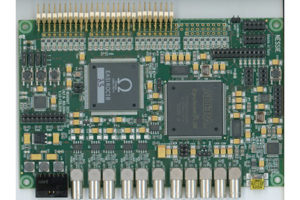
32 Channel Readout board (Nessie)
- Sensor: SiPM SensL 30035FC 3×3 mm2
- 32 channels
- Input: triaxial cable (~ 1.5 m)
- EASIROC (ampli – shaping/fast trigger analog serial out
- FPGA: Altera Cyclone III EP3C16Q240C8N (EASIROC and USB handling – data processing for SiPM calibration/monitoring)
- Out : USB – EASIROC Analog (to Digitizer)
- Main purpose: fast SiPM acquisition – low level signals ( ⪝ mV)
- Critical design issues:
- custom pitch of input connectors
- signal integrity of PCB traces to EASIROC
- filtering and isolation of all power sections
- 6 Layers – 10 boards (so far)
150 x 100 mm
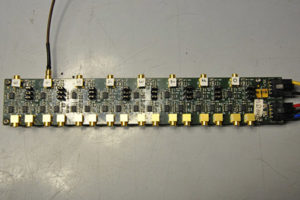
CATB (Ship)
- Sensor:Several SiPM from AdvanSiD (FBK Spin-Off) and Hamamatsu
- Test Board mainly for timing studies (goal: resolution < 1 ns)
- 8 channels
- Input: coaxial cable (~2 m)
- Pre-amplification :1 fast out and 1 slow per channel
- 4 layer – 2 boards
- Out : to Digitizer
- Small-size coaxial connectors (MCX)
224 x 38 mm
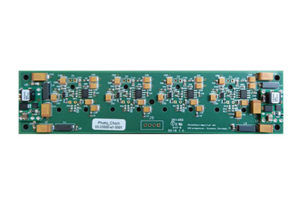
Photo_Chain (A.Montanari)
- Sensor: SI Photodiode Hamamatsu S1087/S1133 series
- 4 channels
- INFN Patent
150 x 36 mm
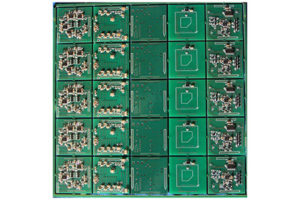
PMT HV Divider (FAMU)
- Sensor: LaBr3 scintillator + PMT
- Active voltage-divider, amplification, power supply
- A unique schematic engineered on 5 distinct PCB due to geometrical detector requirements
- Layout with PADS (Mentor Graphics)
- 2 layers – 20×5 samples
- Critical issues:
- cooling (needs carefully component partition to the 5 PCB)
- connection engineering (multi-board 3D view with PADS)
every board: 45 x 45 mm
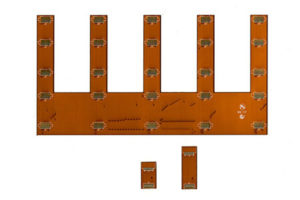
Motherboard (Darkside)
- Sensor: SiPM
- Board Purpose: collect signals fromfront-end devices
- Requirement:
- good thermal behavior (immersed in Liquid Nitrogen @ ~ -190 °C)
- low-radioactivity material
- First Elec.Division design in Kapton
- Critical design issues:
- SiPM signal integrity (controlled impedance striplines between two ground planes)
- stackup and material selection
- 4 Layers – 3 samples (so far)
- Designed with PADS (Mentor Graphics)
- Signal integrity simulated with HyperLynx (Mentor Graphics)
215 x 114 mm
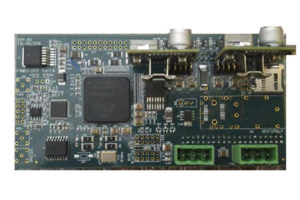
DPP (FAMU)
- Input: 1 analog-digital conversion channel
- AD8138: differential input buffer (-3dB BW @ 320 MHz) acting also as anti-aliasing filter
- ADC: AD9434 12bit @ 500 MS/s (ENOB: 10.5 up to 250 MHz input – 1.5 Vpp)
- FPGA Altera Cyclone V 5CGXC5 (digital filtering and data acquisition)
- Output: Piggy Back Cypress USB 3.0 (max datarate: 5 Gb/s)
- 6 layers – 11 board
- Critical issue: accordion for high-speed USB3 signal from FPGA to Piggy Back connector
65 x 130 mm
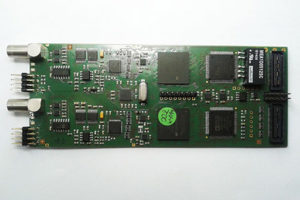
Digitizer Board (Nucl-Ex)
- Input: 2 analog-digital conversion channels
- Anti-aliasing filter (simulated with SPICE)
- ADC: AD9255BCPZ-125 14bit @ 125 MS/s (ENOB: 12 up to 250 MHz input – 2 Vpp)
- Digital Signal Processor: ADSP-2189NKCAZ-320
- 6 layers – 50 mezzanine
- Critical issues:
- input from 100 mV to 8 V (managed with multiple voltage controlled amplifiers and analog multiplexers)
- variable gain and offset (controlled with separated DACs)
140 x 55 mm
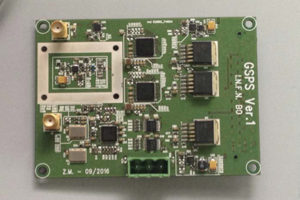
GSPS (Elec.Division R&D)
- FMC mezzanine Card
- Input: 1 analog-digital conversion channel with 2 interleaved ADC
- ADA4930 differential buffer coupled in DC with single ended input (6 dB gain)
- Anti-aliasing filter (simulated with SPICE)
- ADC: AD9434 12bit @ 500 MS/s (ENOB: 10.5 up to 250 MHz input – 1.5 Vpp)
- Output: 12 LVDS x ADC through FMC connector
- 6 layers – 2 cards
- Critical issues:
- filter design
- low-jitter clock distribution ( < 1 ps RMS)
- reconstruction firmware
98 x 70 mm
![]()
IBL/PIXEL ROD (Atlas)
- Input : 32 FE-I4 (160 Mb/s per channel – 5.12 Gb/s in total )
- Control, Data Taking, Monitoring and Calibration
- 14-layer 9U x 400 mm VME64x board
- 1 Xilinx Spartan6 XC6SLX45-FGG484
- 1 Xilinx Virtex5 XC5VFX70T-FF1136: (embedded PowerPC HW core)
- 2 GByte DDR2 SODIMM
- 64 Mbit FLASH Atmel AT45DB642D
- 2 Xilinx Spartan6 XC6SLX150-FGG900:
- 1 2-Gbit DDR2 (Mictor MT47H128M16RT-25E)
- 2 1Mx36 SSRAM (Cypress CY7C1370D-250AXC-ND)
- Cal: 3 Gbit Ethernet interfaces (PHY: DP83865)
- Output: 4 S-Links (5.12 Gb/s in total)
360 x 400 mm
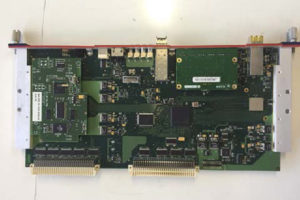
DRM2 (ALICE)
- Input : TRM board (TDC data from MRPC detector) output through VME
- Data Taking, Control, Trigger interface (80 boards foreseen for ’19 Alice upgrade)
- 14 layers – 9U x 160 mm – 5 samples so far (foreseen : ~80)
- GBTx from CERN (rad-hard) : serdes @ 4.8 Gb/s
- FPGA: Microsemi Igloo 2 M2GL90T
- Output: GBTx (~ 3.2 Gb/s user payload)
- Critical issues:
- GBTx handling (interface IP core from CERN has been tested yet)
- Serdes
345 x 162 mm
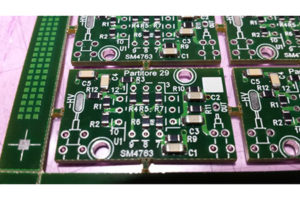
PMT Voltage Divider (Limadou)
- Sensor: Hamamatsu R9880U
- Limadou calorimeter with Plastic Scintillators
- Critical issues:
- Small PCBs/ high voltages : discharges risk
- Outgassing
- Thermal resistance (made with Kapton-Polyamide)
- Redundancy (doubling capacitors)
32 x 20 mm
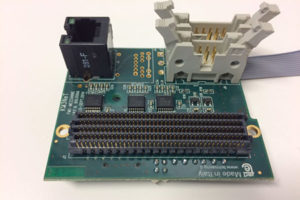
FMC mezzanine for DU Base (Km3NET)
- Near-communication interface board: between the Central Logic Board (CLB) and electronics into (close to) the DU Base
- RS422, RS485, custom protocol on RJ45, FMC to the CLB
- 5 boards so far (foreseen : ~ 100)
- Critical issues:
- galvanic insulation (AC coupling)
- component reliability
- FMC connector mechanics
70 x 50 mm













